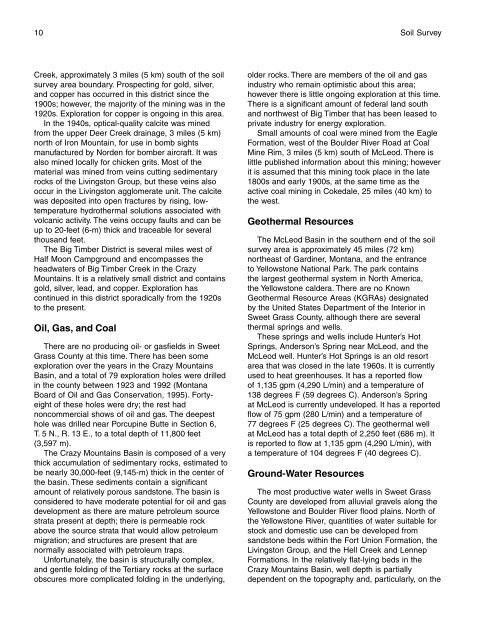Soil Survey of Sweet Grass County Area, Montana - Soil Data Mart
Soil Survey of Sweet Grass County Area, Montana - Soil Data Mart
Soil Survey of Sweet Grass County Area, Montana - Soil Data Mart
Create successful ePaper yourself
Turn your PDF publications into a flip-book with our unique Google optimized e-Paper software.
10 <strong>Soil</strong> <strong>Survey</strong><br />
Creek, approximately 3 miles (5 km) south <strong>of</strong> the soil<br />
survey area boundary. Prospecting for gold, silver,<br />
and copper has occurred in this district since the<br />
1900s; however, the majority <strong>of</strong> the mining was in the<br />
1920s. Exploration for copper is ongoing in this area.<br />
In the 1940s, optical-quality calcite was mined<br />
from the upper Deer Creek drainage, 3 miles (5 km)<br />
north <strong>of</strong> Iron Mountain, for use in bomb sights<br />
manufactured by Norden for bomber aircraft. It was<br />
also mined locally for chicken grits. Most <strong>of</strong> the<br />
material was mined from veins cutting sedimentary<br />
rocks <strong>of</strong> the Livingston Group, but these veins also<br />
occur in the Livingston agglomerate unit. The calcite<br />
was deposited into open fractures by rising, lowtemperature<br />
hydrothermal solutions associated with<br />
volcanic activity. The veins occupy faults and can be<br />
up to 20-feet (6-m) thick and traceable for several<br />
thousand feet.<br />
The Big Timber District is several miles west <strong>of</strong><br />
Half Moon Campground and encompasses the<br />
headwaters <strong>of</strong> Big Timber Creek in the Crazy<br />
Mountains. It is a relatively small district and contains<br />
gold, silver, lead, and copper. Exploration has<br />
continued in this district sporadically from the 1920s<br />
to the present.<br />
Oil, Gas, and Coal<br />
There are no producing oil- or gasfields in <strong>Sweet</strong><br />
<strong>Grass</strong> <strong>County</strong> at this time. There has been some<br />
exploration over the years in the Crazy Mountains<br />
Basin, and a total <strong>of</strong> 79 exploration holes were drilled<br />
in the county between 1923 and 1992 (<strong>Montana</strong><br />
Board <strong>of</strong> Oil and Gas Conservation, 1995). Fortyeight<br />
<strong>of</strong> these holes were dry; the rest had<br />
noncommercial shows <strong>of</strong> oil and gas. The deepest<br />
hole was drilled near Porcupine Butte in Section 6,<br />
T. 5 N., R. 13 E., to a total depth <strong>of</strong> 11,800 feet<br />
(3,597 m).<br />
The Crazy Mountains Basin is composed <strong>of</strong> a very<br />
thick accumulation <strong>of</strong> sedimentary rocks, estimated to<br />
be nearly 30,000-feet (9,145-m) thick in the center <strong>of</strong><br />
the basin. These sediments contain a significant<br />
amount <strong>of</strong> relatively porous sandstone. The basin is<br />
considered to have moderate potential for oil and gas<br />
development as there are mature petroleum source<br />
strata present at depth; there is permeable rock<br />
above the source strata that would allow petroleum<br />
migration; and structures are present that are<br />
normally associated with petroleum traps.<br />
Unfortunately, the basin is structurally complex,<br />
and gentle folding <strong>of</strong> the Tertiary rocks at the surface<br />
obscures more complicated folding in the underlying,<br />
older rocks. There are members <strong>of</strong> the oil and gas<br />
industry who remain optimistic about this area;<br />
however there is little ongoing exploration at this time.<br />
There is a significant amount <strong>of</strong> federal land south<br />
and northwest <strong>of</strong> Big Timber that has been leased to<br />
private industry for energy exploration.<br />
Small amounts <strong>of</strong> coal were mined from the Eagle<br />
Formation, west <strong>of</strong> the Boulder River Road at Coal<br />
Mine Rim, 3 miles (5 km) south <strong>of</strong> McLeod. There is<br />
little published information about this mining; however<br />
it is assumed that this mining took place in the late<br />
1800s and early 1900s, at the same time as the<br />
active coal mining in Cokedale, 25 miles (40 km) to<br />
the west.<br />
Geothermal Resources<br />
The McLeod Basin in the southern end <strong>of</strong> the soil<br />
survey area is approximately 45 miles (72 km)<br />
northeast <strong>of</strong> Gardiner, <strong>Montana</strong>, and the entrance<br />
to Yellowstone National Park. The park contains<br />
the largest geothermal system in North America,<br />
the Yellowstone caldera. There are no Known<br />
Geothermal Resource <strong>Area</strong>s (KGRAs) designated<br />
by the United States Department <strong>of</strong> the Interior in<br />
<strong>Sweet</strong> <strong>Grass</strong> <strong>County</strong>, although there are several<br />
thermal springs and wells.<br />
These springs and wells include Hunter’s Hot<br />
Springs, Anderson’s Spring near McLeod, and the<br />
McLeod well. Hunter’s Hot Springs is an old resort<br />
area that was closed in the late 1960s. It is currently<br />
used to heat greenhouses. It has a reported flow<br />
<strong>of</strong> 1,135 gpm (4,290 L/min) and a temperature <strong>of</strong><br />
138 degrees F (59 degrees C). Anderson’s Spring<br />
at McLeod is currently undeveloped. It has a reported<br />
flow <strong>of</strong> 75 gpm (280 L/min) and a temperature <strong>of</strong><br />
77 degrees F (25 degrees C). The geothermal well<br />
at McLeod has a total depth <strong>of</strong> 2,250 feet (686 m). It<br />
is reported to flow at 1,135 gpm (4,290 L/min), with<br />
a temperature <strong>of</strong> 104 degrees F (40 degrees C).<br />
Ground-Water Resources<br />
The most productive water wells in <strong>Sweet</strong> <strong>Grass</strong><br />
<strong>County</strong> are developed from alluvial gravels along the<br />
Yellowstone and Boulder River flood plains. North <strong>of</strong><br />
the Yellowstone River, quantities <strong>of</strong> water suitable for<br />
stock and domestic use can be developed from<br />
sandstone beds within the Fort Union Formation, the<br />
Livingston Group, and the Hell Creek and Lennep<br />
Formations. In the relatively flat-lying beds in the<br />
Crazy Mountains Basin, well depth is partially<br />
dependent on the topography and, particularly, on the
















